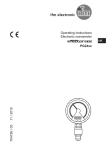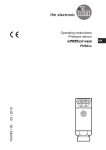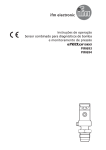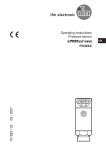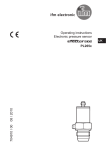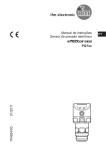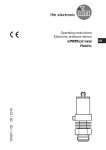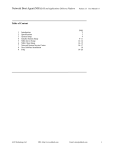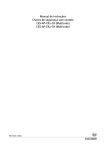Download Operating instructions Electronic pressure sensor PI16xx
Transcript
Operating instructions Electronic pressure sensor UK 704639 / 01 09 / 2010 PI16xx Contents 1 Preliminary note���������������������������������������������������������������������������������������������������3 1.1 Symbols used������������������������������������������������������������������������������������������������3 2 Safety instructions�����������������������������������������������������������������������������������������������3 3 Functions and features����������������������������������������������������������������������������������������4 3.1 Applications���������������������������������������������������������������������������������������������������4 4 Function���������������������������������������������������������������������������������������������������������������4 4.1 Processing of the measured signals��������������������������������������������������������������4 4.2 Pressure monitoring/ analogue function��������������������������������������������������������4 5 Installation�����������������������������������������������������������������������������������������������������������6 6 Electrical connection��������������������������������������������������������������������������������������������8 7 Operating and display elements��������������������������������������������������������������������������9 8 Menu������������������������������������������������������������������������������������������������������������������10 8.1 Menu structure���������������������������������������������������������������������������������������������10 8.2 Menu explanation ��������������������������������������������������������������������������������������� 11 9 Parameter setting����������������������������������������������������������������������������������������������12 9.1 Parameter setting general���������������������������������������������������������������������������12 9.2 Configuring the display (optional)����������������������������������������������������������������14 9.3 Setting the output signal������������������������������������������������������������������������������14 9.3.1 Setting the output function������������������������������������������������������������������14 9.3.2 Scaling the analogue value����������������������������������������������������������������15 9.4 User settings (optional)��������������������������������������������������������������������������������16 9.4.1 Zero-point calibration��������������������������������������������������������������������������16 9.4.2 Setting the damping for the analogue signal��������������������������������������16 9.5 Service functions�����������������������������������������������������������������������������������������16 9.5.1 Reading the min./max. values for the system pressure����������������������16 9.5.2 Reset all parameters to the factory setting�����������������������������������������16 10 Operation���������������������������������������������������������������������������������������������������������17 10.1 Read the set parameter values�����������������������������������������������������������������17 10.2 Fault indication������������������������������������������������������������������������������������������17 10.3 Cleaning of the filter cover�������������������������������������������������������������������������17 11 Scale drawing �������������������������������������������������������������������������������������������������18 2 12 Technical data��������������������������������������������������������������������������������������������������18 12.1 Setting ranges�������������������������������������������������������������������������������������������20 13 Factory setting�������������������������������������������������������������������������������������������������21 UK 1 Preliminary note 1.1 Symbols used ► > […] → Instruction Reaction, result Designation of buttons, switches or indications Cross-reference Important note Non-compliance can result in malfunctions or interference. 2 Safety instructions • Read this ducument before installing the unit. Ensure that the product is suitable for your application without any restrictions. • Non-adherence to the operating instructions or technical data can lead to personal injury and/or damage to property. • In all applications check compliance of the product materials (→ chapter 12 Technical data) with the media to be measured. • For units with cULus approval and the scope of validity cULus → chapter 6 Electrical connection. 3 3 Functions and features The pressure sensor detects the system pressure of machines and installations. 3.1 Applications Type of pressure: relative pressure Order no. PI1693 PI1694 PI1695 PI1696 PI1689 PI1697 PI1698 PI1699 Measuring range bar -1...25 -1...10 -1...4 -0.124...2.5 mbar 5...100 -50...1 000 -12.4...250 -1 000...1 000 PSI -14.4...362.7 -14.5...145 -14.5...58 -1.8...36.24 PSI -0.073...1.45 -0.73...14.5 -0.18...3.62 -14.5...14.5 Permissible Bursting pressure overload pressure bar PSI bar PSI 100 1 450 350 5 070 50 725 150 2 175 30 435 100 1 450 20 290 50 725 bar PSI bar PSI 4 58 30 435 10 145 30 435 10 145 30 435 10 145 30 435 MPa = bar ÷ 10 / kPa = bar × 100 Static and dynamic overpressures exceeding the indicated overload pressure are to be avoided by taking appropriate measures. The indicated bursting pressure must not be exceeded. Even if the bursting pressure is exceeded only for a short time, the unit can be destroyed. NOTE: Risk of injury! 4 Function 4.1 Processing of the measured signals • The unit displays the current system pressure. • It generates 1 output signal according to the parameter setting. OUT analogue signal 4...20 mA (20...4 mA) 4.2 Pressure monitoring/ analogue function The analogue signal can be set. • [OU2] defines whether the set measuring range is provided as a 4...20 mA signal ([OU2] = [I]) or a 20...4 mA signal ([OU2] = [InEG]). 4 Scaling can also be set by means of the teaching process or by entering a value for the ASP and AEP parameters. • By teaching the analogue start point (tASP) or setting the parameter ASP you define the measured value at which the output signal is 4 mA (20 mA at [InEG]). • By teaching the analogue end point (tAEP) or setting the parameter AEP you define the measured value at which the output signal is 20 mA (4 mA at [InEG]). Minimum distance between [ASP] and [AEP] = 25 % of the final value of the measuring range (turn down 1:4). Factory setting Measuring range scaled UK P = system pressure, MAW = initial value of the measuring range, MEW = final value of the measuring range 1 : [OU2] = [I]; 2 : [OU2] = [InEG] The output signal is between 4 and 20 mA ([OU2] = [I]) or between 20 and 4 mA ([OU2] = [InEG]). It is also indicated: • System pressure above the measuring range: -- output signal > 20 mA if [OU2] = [I]. -- output signal between 4 and 3.8 mA if [OU2] = [InEG]. • System pressure below the measuring range: -- output signal between 4 and 3,8 mA if [OU2] = [I]. -- output signal > 20 mA if [OU2] = [InEG]. 5 5 Installation Ensure that no pressure is applied to the installation while mounting or removing the sensor. Please note: Display „0%“ does not mean that the system is free of pressure! Horizontal mounting recommended for high medium temperatures. ►► Screw the sensor into a G 1 process fitting. ►► Tighten the sensor with a spanner. Tightening torque: 20 Nm. A = freely rotatable housing The unit is adaptable for various G 1 process fittings. G 1 process adapters to be ordered separately as accessories. 6 Mounting 1 3 UK 2 ►► Screw the unit into the adapter (A) until it is hand-tight (fig. 1). Do not damage the sealing chamfers. ►► Clamp sensor and adapter into a clamping device (B); (fig. 2). Tighten the clamping device only slightly so that the adapter does not warp. ►► Tighten the sensor using a spanner . Tightening torque: 20 Nm. ►► Fix the unit + adapter to the process connection by means of a coupling nut, a clamp flange or the like (C); (fig 3). NOTE: A guarantee for a long-term stable sealing of the metal seal is only valid for once-only mounting. Welding adapter ►► First weld the adapter, then mount the sensor. Follow the instructions included with the adapter. 7 6 Electrical connection The unit must be connected by a qualified electrician. The national and international regulations for the installation of electrical equipment must be adhered to. Voltage supply to EN50178, SELV, PELV. For units with cULus approval and the scope of validity cULus: The device shall be supplied from an isolating transformer having a secondary Listed fuse rated as noted in the following table. Overcurrent protection Control-circuit wire size AWG (mm2) 26 (0.13) 24 (0.20) 22 (0.32) 20 (0.52) 18 (0.82) 16 (1.3) Maximum protective device rating Ampere 1 2 3 5 7 10 The Sensor shall be connected only by using any R/C (CYJV2) cord, having suitable ratings. ►► Disconnect power. ►► Connect the unit as follows: Normal operation Programming operation Pin 1 Ub+ Pin 3 UbPin 4 (P) P = communication via EPS / FDT interface Pin 2 (OUT2) analogue output for system pressure Core colours of ifm sockets: 1 = BN (brown), 2 = WH (white), 3 = BU (blue), 4 = BK (black) 8 7 Operating and display elements UK 1 to 8: Indicator LEDs -- LED 1 to LED 6 = system pressure in unit of measurement as indicated on the label. LEDs 5 to 6 not used for units with 4 adjustable units of measurement. -- LED 7 not used. -- LED 8 not used. 9: Alphanumeric display, 4 digits -- Indication of the current system pressure. -- Indication of the parameters and parameter values. 10: Set pushbutton -- Setting of the parameter values (scrolling by holding pressed, incremental by pressing briefly). 11: Mode/Enter pushbutton -- Selection of the parameters and acknowledgement of the parameter values. 9 8 Menu 8.1 Menu structure 10 8.2 Menu explanation OU2 tCOF tASP tAEP EF Uni SELd ASP AEP HI LO COF dAA diS rES Output function for OUT2: •Analogue signal for the current system pressure: 4...20 mA [I] or 20...4 mA [InEG]. Teaching zero-point calibration. Teaching analogue start point for the system pressure: set value at which 4 mA are output (20 mA on [OU2] = [InEG]). Teaching analogue end point for the system pressure: set value at which 20 mA are output (4 mA on [OU2] = [InEG]). UK Extended functions / Opening menu level 2. Standard unit of measurement for the system pressure. Display mode: •Pressure in the unit set in [Uni]. •Pressure in % of the set scaling of the analogue output. Analogue start point for the system pressure: measured value at which 4 mA are output (20 mA on [OU2] = [InEG]). Analogue end point for the system pressure: measured value at which 20 mA are output (4 mA on [OU2] = [InEG]). Maximum value memory for the system pressure. Minimum value memory for the system pressure. Zero point calibration. Damping for the analogue output. Update rate and orientation of the display. Restore the factory setting. 11 9 Parameter setting During the parameter setting process the unit remains in the operating mode. It continues its monitoring function with the existing parameters until parameter setting has been terminated. 9.1 Parameter setting general Each parameter setting requires 3 steps: 1 Selecting parameter ►► Press [Mode/Enter] until the requested parameter is displayed. 2 Setting the parameter value ►► Press [Set] and keep the buton pressed. >> Current setting value of the parameter bit flashes for 5 s. >> After 5 s: Setting value is changed: incremental by pressing briefly or scrolling by holding pressed. The numerical values are incremented continuously. If the value is to be reduced: Let the display move to the maximum setting value. Then the cycle starts again at the minimum setting value. 3 Acknowledge parameter value ►► Press [Mode/Enter] briefly. >> The parameter is displayed again. The new setting value is stored. Set more parameters ►► Start again with step 1. Finishing parameter setting ►► Press [Mode/Enter] several times until the current measured value is displayed or wait for 15 s. >> The unit returns to the operating mode. 12 • Changing from menu level 1 to menu level 2: ►► Press [Mode/Enter] until [EF] is displayed. ►► Press [Set] briefly. >> The first parameter of the submenu is displayed (here: [Uni]). If menu level 2 is protected by an access code, „Cod1“ flashes in the display. ►► Press [Set] and keep it pressed until the valid code no. is displayed. ►► Press [Mode/Enter] briefly. Delivery by ifm electronic: no access restriction. UK • Locking / unlocking The unit can be locked electronically to prevent unintentional wrong settings. ►► Ensure that the unit is in the normal operating mode. ►► Press [Mode/Enter] + [Set] for 10 s. >> [Loc] is displayed. During operation: [Loc] is displayed briefly when you try to change parameter values. For unlocking: ►► Press [Mode/Enter] + [Set] for 10 s. >> [uLoc] is displayed. On delivery: Unlocked. • Timeout: If no button is pressed for 15 s while the parameters are being set, the unit returns to the operating mode with unchanged values. 13 9.2 Configuring the display (optional) ►► Select [Uni] and set the unit of measurement: -- [bAr], [mbAr], -- [MPA], [kPA], -- [PSI], -- [InHO] (only PI1689, PI1696, PI1697, PI1698, PI1699), -- [mWS] (only PI1696, PI1697, PI1699), -- [mmWS] (only PI1689 and PI1698). ►► Select [SELd] and set the display mode: -- [P]: Pressure in the unit set in Uni. -- [P%]: percentage value (pressure in % of the set scaling of the analogue output. The following applies: 0% = ASP value; 100% = AEP value). NOTE: Display „0%“ does not mean that the system is free of pressure. ►► Select [diS] and set update rate and orientation of the display: -- [d1]: Update of the measured value every 50 ms. -- [d2]: Update of the measured value every 200 ms. -- [d3]: Update of the measured value every 600 ms. -- [rd1], [rd2], [rd3]: Display like d1, d2, d3; rotated by 180°. -- [OFF]: The display is deactivated in the operating mode. If one of the buttons is pressed, the current measured value is displayed for 15 s. Another press of the Mode/Enter button opens the Display mode. The LEDs remain active even if the display is deactivated. 9.3 Setting the output signal 9.3.1 Setting the output function ►► Select [OU2] and set the anologue function: -- [I] = current signal proportional to the pressure 4…20 mA, -- [InEG] = current signal proportional to the pressure 20…4 mA. 14 9.3.2 Scaling the analogue value ►► Set the requested minimum pressure in the system. ►► Press [Mode/Enter] until [tASP] is displayed. ►► Press [Set] and keep the buton pressed. >> The currently set value flashes. ►► Release [Set] when the display stops flashing. >> The new set value is displayed. ►► Press [Mode/Enter] briefly. >> The current system pressure is defined to be the start value for the analogue signal. ►► Set the requested maximum pressure in the system. UK ►► Press [Mode/Enter] until [tAEP] is displayed. ►► Press [Set] and keep the buton pressed. >> The currently set value flashes. ►► Release [Set] when the display stops flashing. >> The new set value is displayed. ►► Press [Mode/Enter] briefly. >> The current system pressure is defined to be the end value for the analogue signal. ASP / AEP can only be taught within defined limits (→ 12.1 setting ranges). If the teaching process is carried out at an invalid pressure, [UL] or [OL] is displayed. After acknowledgement by [Mode/Enter], [Err] flashes, the ASP value / AEP value is not changed. As an alternative: ►► Select [ASP] and set measured value at which 4 mA are output (20 mA at [OU2] = [InEG]). ►► Select [AEP] and set measured value at which 20 mA are output (4 mA at [OU2] = [InEG]). Minimum distance between ASP and AEP = 25 % of the final value of the measuring range (scaling factor 1:4). 15 9.4 User settings (optional) 9.4.1 Zero-point calibration ►► Select [COF] and set a value between -5% and 5% of the final value of the measuring range. The internal measured value “0” is shifted by this amount. As an alternative: Automatic adaptation offset (setting range 0 bar ±5%); e.g. in the event of a deviation of the mounting location of the sensor and the zero point level for level measurement. ►► Make sure that no pressure is applied to the system. ►► Press [Mode/Enter] until [tCOF] is displayed. ►► Press [Set] and keep the buton pressed. >> The current offset value (in %) briefly flashes, then the current system pressure (in the selected display unit) is displayed. ►► Release [Set]. ►► Press [Mode/Enter] briefly to confirm the new offset value. 9.4.2 Setting the damping for the analogue signal ►► Select [dAA] and set value between 0.1 and 100.0 s (at 0.0 = [dAA] is not active). dAA value = response time between pressure change and change of the analogue signal in seconds. 9.5 Service functions 9.5.1 Reading the min./max. values for the system pressure ►► Select [HI] or [LO], press [Set] briefly. [HI] = maximum value, [LO] = minimum value. Delete memory: ►► Select [HI] or [LO]. ►► Press [SET] until [----] is displayed. ►► Press [MODE/ENTER] briefly. 9.5.2 Reset all parameters to the factory setting ►► Select [rES] ►► Press [SET] until [----] is displayed. ►► Press [MODE/ENTER] briefly. It makes sense to note down your own settings before executing the function (→ 13 Factory preset). 16 10 Operation After power on of the supply voltage the unit is in the Run mode (= normal operation). It carries out its measurement and evaluation functions and generates output signals according to the set parameters. Operating indicators → chapter 7 Operating and display elements. 10.1 Read the set parameter values ►► Press [Mode/Enter] until the requested parameter is displayed. ►► Press [Set] briefly. >> The unit displays the corresponding parameter value for about 15 s. After another 15 s the unit returns to the Run mode. UK 10.2 Fault indication [OL] [UL] [Err] Overload pressure (measuring range exceeded). Underpressure range (measuring range below the minimum value). Internal fault, invalid input (indicated even if the display is deactivated). 10.3 Cleaning of the filter cover If viscous and residues producing media clog the filter cover of the sensor (and thus reduce the measuring accuracy slightly), you can clean it. ►► Unscrew the filter cover (B) (use a pair of pliers with plastic-covered jaws for this). ►► Clean the cover thoroughly. The vent (A) should only be cleaned by skilled personnel and with utmost care. Possible medium residues must not be compressed and pressed into the vent. This could clog the filter system and reduce the measuring accuracy of the sensor. ►► Screw the filter cover again tightly. 17 11 Scale drawing Dimensions are in millimeters 1: display 2: LED’s 3: programming button 12 Technical data Operating voltage [V]............................................................................................ 20...32 DC Reverse polarity / overload protection, integrated watchdog Power-on delay time [s].................................................................................................... 0.5 Analogue output ............................................................................... 4...20 mA / 20...4 mA Max. load current output [Ω] ........................................................................................... 300 Switch-on peak current.................................................................................. 60 mA (30 ms) Step response time analogue output [ms] ........................................................................ 40 18 Accuracy / deviation (in % of the span)1) Characteristics deviation (linearity. incl. hysteresis and repeatability)2) Linearity Hysteresis Repeatability (with temperature fluctuations < 10 K) Long-term stability (in % of the span per year) PI169x PI1689 < ± 0.2 < ± 0.5 < ± 0.15 < ± 0.15 < ± 0.1 < ± 0.1 < ± 0.15 < ± 0.15 < ± 0.1 < ± 0.1 - Temperature coefficient (TC) in the compensated temperature range 0 ... 70°C (in % of the span per 10 K) PI169x PI1689 Greatest TC of the zero point < ± 0.05 < ± 0.1 Greatest TC of the span < ± 0.15 < ± 0.2 UK Material (wetted parts) .................................... stainless steel 316L / 1.4435, surface characteristics: Ra 0.4 / Rz 4 ceramics (99.9 % Al2 O3); PTFE; Housing materials ......... stainless steel 316L / 1.4404; PC (Makrolon); PBT (Pocan); PEI; FPM (Viton); PTFE Protection ........................................................................................................IP 67 / IP 69K Protection class...................................................................................................................III Insulation resistance [MΩ]..........................................................................> 100 (500 V DC) Shock resistance [g]................................................................ 50 (DIN / IEC 68-2-27, 11ms) Vibration resistance [g].................................................. 20 (DIN / IEC 68-2-6, 10 - 2000 Hz) Switching cycles min............................................................................................ 100 million Operating temperature [°C]................................................................................... -25 ... +80 Medium temperature [°C]................................................................. -25...125 (145 max. 1h) Storage temperature [°C]...................................................................................... -40...+100 EMCEN 61000-4-2 ESD:.........................................................................................4 / 8 KV EN 61000-4-3 HF radiated:............................................................................... 10 V/m EN 61000-4-4 Burst:.............................................................................................2 KV EN 61000-4-5 Surge: ...................................................................................0.5 / 1 KV EN 61000-4-6 HF conducted:............................................................................... 10 V 1) all indications are referred to a turn down of 1:1 2) limit value setting to DIN 16086 19 12.1 Setting ranges PI1689 ASP mbar kPa inH2O PI1698 PI1697 PI1696 PI1695 PI1694 PI1693 mmWS bar PSI MPa bar PSI MPa bar PSI kPa bar PSI kPa inH2O mWS mbar PSI kPa inH2O mWS mbar kPa inH2O mmWS ΔP = increments 20 min 5.0 -0.50 -2.00 -51 -1.00 -14.4 -0.100 -1.00 -14.5 -0.100 -1.000 -14.50 -100.0 -0.124 -1.80 -12.4 -50 -1.26 -50 -0.73 -5.0 -20.0 -0.51 -12.4 -1.24 -5.0 -126 AEP max 75.0 7.50 30.12 765 18.74 271.8 1.874 7.50 108.7 0.750 3.000 43.50 300.0 1.880 27.27 188.0 755 19.17 750 10.88 75.0 301.2 7.65 187.4 18.74 75.3 1912 min 20.0 2.00 8.04 204 5.24 76.2 0.524 1.50 21.8 0.150 0.000 0.00 0.0 0.500 7.26 50.0 201 5.10 200 2.90 20.0 80.4 2.04 50.0 5.00 20.1 510 max 100.0 10.00 40.16 1020 25.00 362.7 2.500 10.00 145.0 1.000 4.000 58.00 400.0 2.500 36.27 250.0 1004 25.49 1000 14.50 100.0 401.6 10.20 250.0 25.0 100.4 2250 ΔP 0.1 0.01 0.04 1 0.02 0.3 0.002 0.01 0.1 0.001 0.005 0.05 0.5 0.002 0.03 0.2 1 0.01 1 0.01 0.1 0.4 0.01 0.2 0.02 0.1 2 ASP PI1699 mbar PSI kPa inH2O mWS ΔP = increments min -1000 -14.50 -100.0 -401 -10.20 AEP max 500 7.25 50.0 201 5.10 min -500 -7.25 -50.0 -201 -5.10 max 1000 14.50 100.0 401 10.20 ΔP 1 0.05 0.1 1 0.01 UK 13 Factory setting OU2 ASP / tASP AEP / tAEP COF / tCOF dAA Uni SELd dis Factory setting I 0% VMR* 100% VMR* 0.0 0.1 bAr / mbAr P d2 User setting * = the indicated percentage of the final value of the measuring range (VMR) of the corresponding sensor in bar / mbar is set. More information at www.ifm.com 21





















